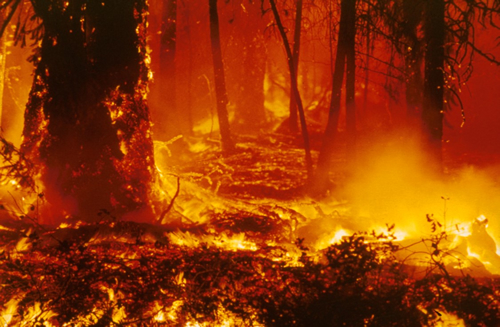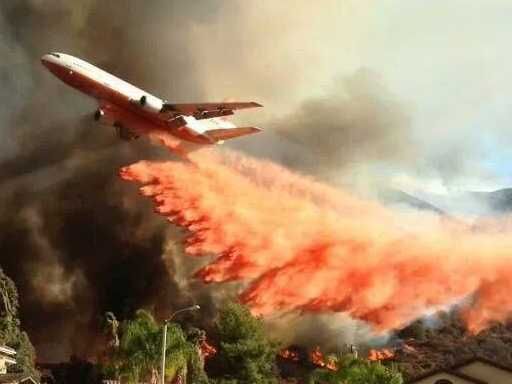
A wildfire in Northern California (Photo: USDA.gov)
Two Words Explain California’s Wildfire Woes: Spotted Owl
The owl became a cause célèbre for people who had never seen one and never would
By Kevin Nelson, October 13, 2022 10:41 am
Some things in life are hard to understand and explain. The theory of relativity, for example, or the origins of black holes. Other things are easy to grasp, however.
Such as: California’s wildfire woes. In the past five years summer and fall firestorms have killed dozens of people, wiped out homes, businesses and entire communities, torched millions of acres of forestlands, caused billions in property losses, and swept away untold numbers of animals and wildlife.
The cause of all this wreckage is easy to pinpoint. It’s simple as two words: spotted owl.
In the 1980s California was a superstar timber producer. Nearly 150 sawmills churned out four billion board feet of lumber every year, leading the nation. Working-stiff loggers had money in their pockets, their families thrived, and little lumber towns tucked away in the north woods boomed.
Enter the spotted owl. A night-flying denizen of the deep woods, the owl became a cause célèbre for people who had never seen one and never would. When the government moved to protect it as a threatened species, it ushered in an ugly slugfest pitting environmentalists, California state officials and the U.S. Forest Service against loggers and the timber industry.
The fight was over protecting the owl’s habitat. After lawsuits, protests and even violence, the environmentalists won.
And, in the process, delivered a death blow to an entire way of life. Sawmills shut down, loggers lost their jobs, and those little backwoods lumber towns went from boom to 1930s Depression-era bust.
“It was like turning off the spigot,” said Ryan Tompkins, a Plumas County forester and natural resources consultant quoted by writer Jane Braxton Little in the latest issue of Bay Nature Magazine.
Little’s excellent, deeply researched article focuses on the roughly 200,000 private owners of forest lands in California, totaling some nine million acres. The Forest Service controls the bulk of the forests in the state, with 19 million acres under its jurisdiction. Its management, or mismanagement, of these resources is a major reason why California and other western states where the USFS has a big footprint are in the mess they’re in.
From 1988 to 2011, Little writes that the number of wildfires in California “increased by seven large fires annually.” It is no coincidence that 1988 was the year the spotted owl received protection. Over the past five years the wildfire situation has grown even worse. Seven of the deadliest fires in state history have occurred in that period. The state’s annual fire season now extends from June or July into late fall.
The wildfires have gotten wilder too—bigger, deadlier, harder to contain and put out. Last year’s Dixie Fire laid waste to a million acres of land, earning the unhappy title of California’s biggest fire. And, as with all these major conflagrations, it spread smoke up and down the state, darkening skies and poisoning the air.
At the risk of over-simplification, the prevailing forest management wisdom in the post-spotted owl era has been: Don’t touch those trees. Leave ‘em where they be, for people coming up from the city to enjoy on the weekends. And sue and regulate the hell out of anyone who dares try to make a profit by harvesting them.
In the go-go days of the ‘80s the timber industry harvested two billion board feet of lumber a year on public lands. That figure has since fallen to 60 million board feet annually. The federal Northwest Forest Plan adopted in the mid-1990s reduced logging in national forests by 80 percent.
But now, the thinking in the smart set appears to be changing. “Sometimes,” a director of the environmental group Save the Redwoods League told Little, “the best approach requires using a chainsaw.” Along with controlled burns, selective thinning of drought-ridden trees and underbrush in California’s densely packed forests may be the best way out of this crisis. Less woodsy material means less material to burn, rendering the fires that do occur less potent.
That’s the hope anyhow, but there’s a catch. California’s once-mighty timber industry has become a shell of what it once was. Over half the sawmills from the old days are gone. So, too, are scores of industry-related support businesses. The ranks of professional foresters have been decimated, and the same holds true for the loggers—the men who actually wield those chainsaws.
Additionally, the knowledge base is almost extinct. Fewer people know how to do the things that generations of logging families once took for granted, and those who still retain these skills are often old-timers whose time is running out.
The irony here is that environmentalists, the state and the USFS are now in need of the very industry they have vilified and fought for so long. According to Dan Porter of the Nature Conservancy, the critical lack of timber industry infrastructure and know-how is “one of the biggest barriers to scaling ecological forest management.”
So let me be sure I have this right:
You identify a “problem” and then destroy a way of life as a means of solving that perceived problem. But then your “solution” creates an even bigger mess, one that causes you to go back to the very people whose communities and livelihoods you trashed, asking them to help you with your latest bright idea. But these small town Americans have themselves become an endangered species.
Meanwhile, has anyone seen a spotted owl lately?
- The Big Green of Money Against the Farmers and Ranchers of Solano - May 31, 2024
- Flag-Waving Tribute to the Men Who Fought on D-Day - May 29, 2024
- Charles Swanston’s Headless Rancher Statue is a Casualty of War - January 4, 2023




Not to mention the massive “Carbon Footprint” that’s created when all those forests go up in smoke, along with the spotted owl habitat…
“Environmentalists” are mentally ill grifters, basically, who do not use an ounce of rational thinking…
the eco-terrorists will end civilization
I remember the spotted owl crisis. It was what brought us from paper bags to plastic at the grocery stores and killed proper forestry management by stopping logging. (I hated plastic grocery bags from the beginning!) California environmental activists have almost single-handedly destroyed housing development, water management and agriculture in the state. They need to lose some of the power they wield, but who has the guts to take them on?
Just one word explains lots of fires: “Pyroterrorism”. Look that up on Google.
Excellent explanation of environmental destruction in the name of environmental protection. It’s about time we used our heads in place of our feelings.
There are better ways of managing forests than clear cutting. Simple management is very effective. In fact they are doing that now. Why not then? Maybe it’s because unaware people decided it was easier to cut trees down. When you go into nature do you think ” I want to cut these trees down?” Usually not. California’s magnificent beauty is because of the trees and the mountains, ocean, weather… As for the timber industry, I for one, and I’m sure many of us that live in the woods of northern California are happy that tree milling stopped. The finite resources of trees shouldn’t be the standard building materials when there are so many better options. I live in the woods. I am part of the conversation to conserve. And yes I have Northern Spotted Owl in my back yard and I’m damn glad I do. Maybe if others experienced this life, they wouldn’t be so quick to get on the cut the trees narrative. Oh.. and I’m a Republican.
And yet the spotted owl population has significantly declined:
https://abcbirds.org/spotted-owl-populations-are-dropping-rapidly-study-says/
https://www.fs.usda.gov/pnw/publications/range-wide-declines-northern-spotted-owl-populations-pacific-northwest-meta-analysis
Thanks Mr. Nelson for reporting on the devastating policies of the environmentalist (Democrats). We know the legacy media, Sac Bee, San Jose Mercury News, S.F Chronicle and he L.A Times will not report on the truth. Northern California communities have suffered from job loss but more importantly high useage of drugs. Very sad. The left destroys everything.
The Sacramento Bee in the late ’90s article ran an article that was titled something like “Was an industry destroyed to save a bird that wasn’t in peril?”. In it, Gregg Easterbrook, the writer, spent time with a Simpson Timber Company biologist on the north coast that had inventoried company lands for mating pairs of Northern Spotted Owls. He had documented that there were more pairs on company ground than had been thought to exist in all of Northern California at that time. At one point during Mr. Easterbrook’s visit, while he and Simpson’s biologist were sitting on a tailgate eating lunch, the biologist was feeding mice to an owl off of a stick he would hold up. This happened in a section of second growth ground on company land, within sight of a haul road where logging trucks were rumbling past.
Was an industry destroyed to save a bird that wasn’t in peril? Yes. And the enviros knew it all along. And so did everyone in the timber industry, but their opinion was ignored. After all, they were just “a bunch of dumb loggers”. A bunch of dumb loggers that had it right all along.
BTW, Mr. Nelson’s article is fantastic. He absolute nails where we’re at today, thanks to the people who supposedly care about saving the forests while millions of acres of it burn, thanks to their policies.
I think we should sue the State and the Environmentalists for wrecking the air,the little secret that they and the media don’t mention is that these fires release more toxins than all the cars and trucks on the road for up to a decade.
If what I am about to write is true, and I have no reason disbelieve the person who told me the information, it will surprise and anger many people. I lived in Calaveras county for a time amd knew someone who worked for the forest service. This person told me that a survey was done; a sort of census to find out how many Spotted Owls were in the area. Basically, they would tie a string to a white mouse and place the mouse in the forest at night and wait for an owl to strike. To their surprise, they spotted far more Spotted Owls than they thought possible.
The man told me that they saw so many owls (at least in that area) that the idea of the species being endangered was an outright falsehood. This was in 2005.
Another lie, from the very beginning, was that Northern Spotted Owls were old-growth dependent. They’re not. Old growth forests are generally closed canopied forests, where little to no sunlight reaches the ground. This doesn’t allow the vegetation that supports the main food source of the owls, which is mice and voles, to flourish.
From the very beginning, the spotted owl lie wasn’t to save the owls, it was to end logging of national forests. Once that was accomplished they planned to go after logging on private ground. And in a perfect example of enviro unintended consequences, this accelerated the logging of large trees on private ground for fear their operations might soon be shut down.
Fortunately, their lie caught up to them, even though the Forest Service had already been locked into paralysis by analysis.
Another after-effect of the huge fires is that bears and other wildlife are moving down to lower elevations to find sustenance. We were “beneficiaries” of having bears in our vineyard this year for the first time. They wiped out more than half of our crop. The economic effects will be tough to take if this continues, which I have little doubt it will.
I can explain it in one word. Greens (more accurately Browns) .
I live up in the Mother Lode country and somebody is still logging. I see trucks up here hauling out trees that are burnt on the outside but fine on the inside. Someone is making bank on these trees. Cal Fire also said that since the beginning of this year there have been hundreds of arsonists arrested. Nothing to see here.
If you are implying that its timber industry people setting these fires your accusation is scurrilous. For your information the largest timberland owner and sawmill operator in California is Sierra Pacific Industries, which owns 2.2 million acres, much of which has burned in the last several years. They don’t need federal salvage timber. They’re busy cleaning up their own ground and trying to get it back into being productive timberland again. And much of their timberlands have burned because it’s located adjacent to national forest land, which has been mismanaged to the point of being a catastrophic fire waiting to happen.
Here’s a suggestion. Why don’t you follow one of those empty log trucks back into the woods and see if you can talk to the logger about what’s going on? He might just be willing to enlighten you about these burns and what’s causing them. That would be a more productive use of your time than watching trucks go up and down the road and slinging ridiculous accusations on the internet.
I had seen a chart that showed the correlation between forest acres burned in wildfire and the spotted owl act and it matches perfectly. This article is right on. Anyone who blames the increase on wildfires on Climate Change is completely blind to the truth.
Correlation is not the same as causation. And anecdotal stories are not the same as reality. Fire is part of the landscape and fire suppression, logging, and climate change made it worse. Protecting a portion of the forest for owls is not the same as the cause any more than the rise of the internet is correlated with wildfires.